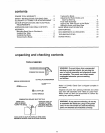
If anypartis missing,bent,or brokenin anyway,or
anyelectricalpartdoesn'tworkproperly,turnthesaw
offandunplugthesaw REPLACEdamaged,miss-
ing,orfailedpartsbeforeusingthesawagain
MAINTAINTOOLSWiTHCAREKeepthesawclean
for bestandsafestperformanceFollowinstructions
forlubricating
REMOVEADJUSTINGKEYSANDWRENCHES
fromtoo!beforeturningit on
Dress for safety,
WEAR YOUR
To avoid injury from jams, slips or thrown pieces:
• Choose the right size and style blade for the
material and the type of cutting you plan to do
• USE ONLY RECOMMENDED ACCESSORIES
(See page 18) Consult this owner's manual for
recommended accessories FoIlow the instruc-
tions that come with the accessories The use of
improper accessories may cause risk of injury to
persons
• Make sure the blade teeth point downward,
toward the table
• Make sure the blade guides and thrust bearings
are properly adjusted
• Make sure the blade tension is properly adjusted,
. Make sure the table lock knob is tight and no
parts have excessive play
. To avoid accidental blade contact, minimize
blade breakage and provide maximum blade
support, always adjust the upper blade guide and
blade guard to just clear the workpiece
• KEEP WORK AREA CLEAN Cluttered areas
and benches invite accidents Floor must not be
slippery
To avoid burns or other fire damage, rlever use the
saw near flammable liquids, vapors or gases
Plan ahead to protect your eyes,
hands, face, ears.
KNOW YOUR SAW Read and understand the
owner's manual and labels affixed to the tool_ Learn
its application and limitations as well as the specific
potential hazards peculiar to this tool
To avoid injury from accidental contact with moving
parts, don't do layout, assembly, or setup work on the
saw while any parts are moving.
AVOID ACCIDENTAL STARTING Make sure switch
is "OFF" before plugging saw into a power outlet
Plan your work.
• USE THE RIGHT TOOL Don't force tool or
attachment to do a job it was not designed to do
• Use this band saw to cut onty wood, wood like
products, and plastics
Any power saw can throw foreign objects into the
eyes This can cause permanent eye damage Wear
safety goggles (not glasses) that comply with ANSI
Z871 (shown on package) Everyday eyeglasses
have only impact resistant lenses They are not safe-
ty glasses Safety goggles are available at Sears
retait catalog stores Glasses or goggles not in c0m_
pliance with ANSI Z87 ! could seriously hurt you
when they break
• Do not wear Ioose clothing, gloves, neckties or
jewelry (rings, wrist watches) They can get
caught and draw you into moving parts
• Wear nonslip footwear
• Tie back long hair
• Roll long sleeves above the elbow
• Noise levels vary widely To avoid possible hear-
ing damage, wear ear plugs or muffs when using
your saw for hours at a time
• For dusty operations wear a dust mask along
with the safety goggles
Inspect your workpiece_
Make sure there are no nails or foreign objects in the
part of the workpiece to be cut
Use extra caution with large, very small or awk-
ward workpieces:
• Use extra supports (tables, saw horses, blocks.
etc ) for any workpieces large enough to tip when
not held down to the table top
• NEVER use another person as a substitute for a
table extension, or as additional support for a
workpiece that is longer or wider then the basic
saw table, or to help feed, support or pull the
workpiece
• When cutting irregularly shaped workpieces, plan
your work so it will not pinch the blade. A piece
of molding, for example, must lay flat or be held
by a fixture or jig that will not let it twist, rock or
slip while being cut
. Properly support round materiat such as dowel
rods, or tubing They have a tendency to roll dur-
ing a cut, causing the blade to "bite" To avoid
this, always use a "V" block or clamp the work to
the miter gage
• Cut only one workpiece at a time
• Clear everything except the workpiece and relat-
ed support devices off the table before turning
the saw on


















